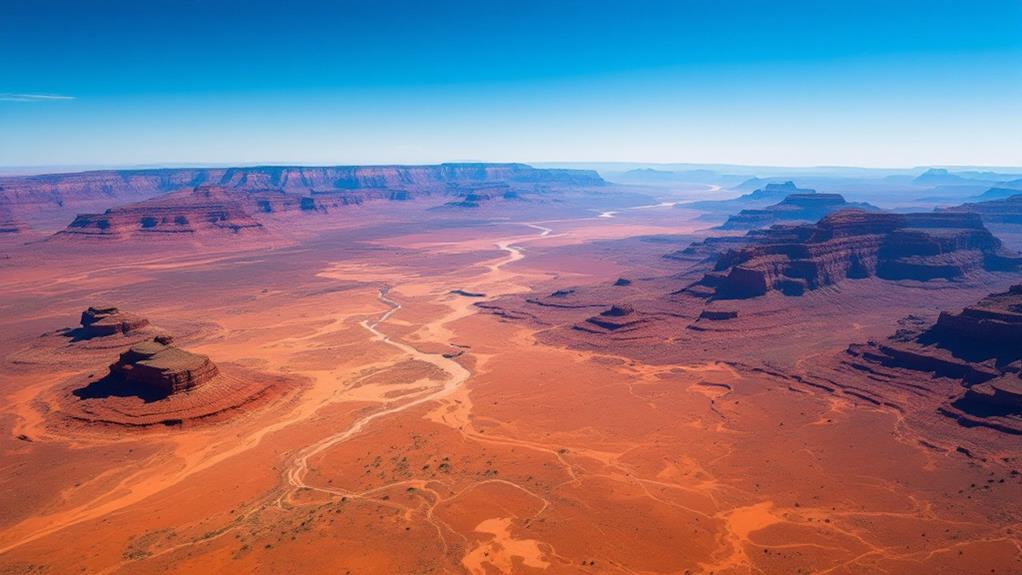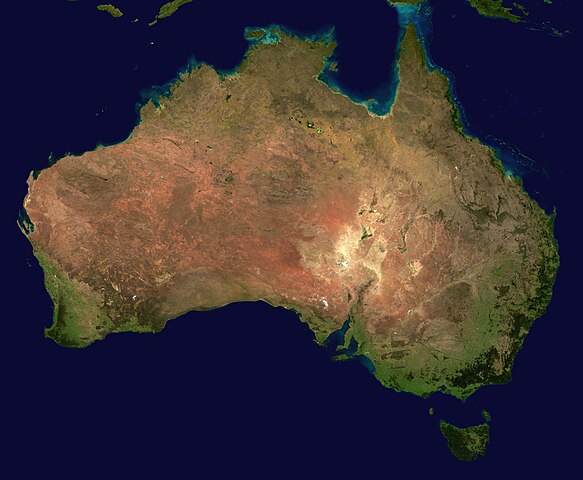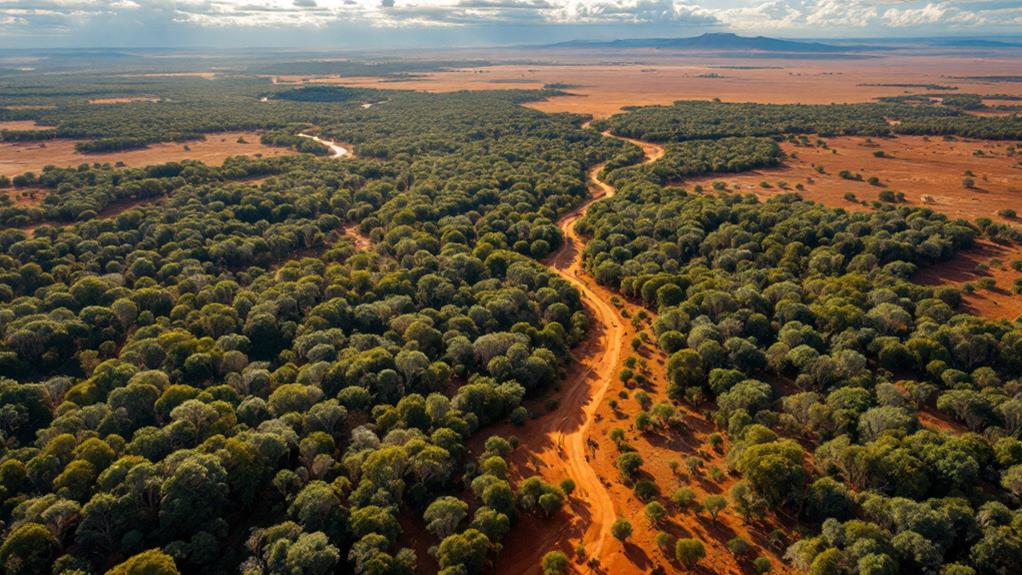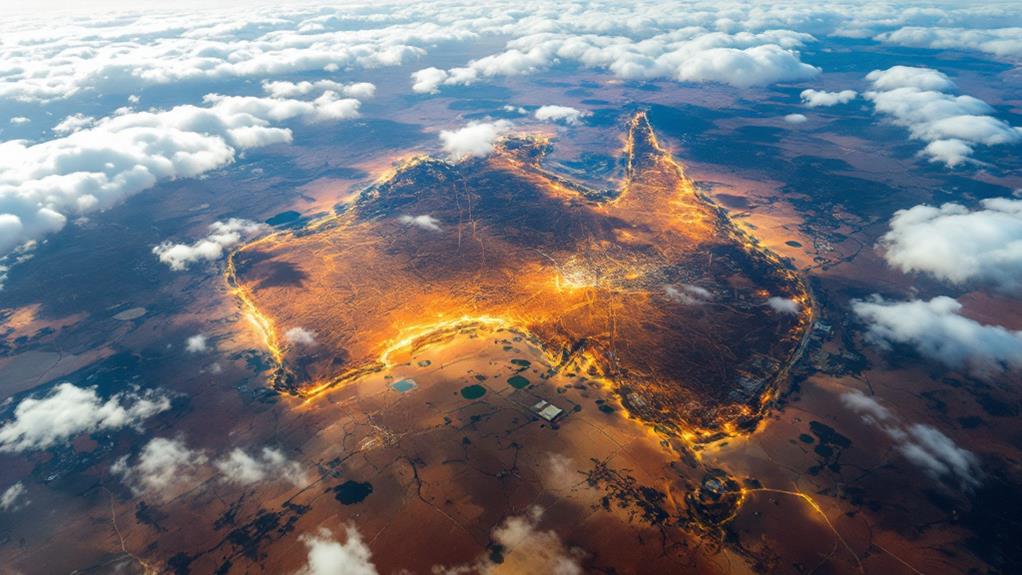How Much of Australia Is Uninhabited? Exploring the Country’s Vast Wilderness

You'll be amazed to learn that over 85% of Australia is uninhabited, offering a vast wilderness steeped in natural beauty and cultural significance. Most Australians choose to live along the coast, leaving the arid interior largely untouched. This massive expanse features a challenging climate with temperatures often exceeding 104°F, making it tough for large-scale settlements to thrive. Indigenous Australians have adapted to and respected this land for millennia, maintaining its pristine condition. As urban areas take up only a small fraction of the land, opportunities for development and exploration abound if you're curious enough to uncover them.
Geographic Overview

While Australia ranks as the sixth largest country globally, you'll find its vast interior largely uninhabited due to its challenging climate and rugged terrain. This massive land covers approximately 3 million square miles, yet only a small fraction is occupied by people. The harsh conditions of the interior, including hot and arid climates, make it difficult for communities to thrive there. Instead, Australians have opted to settle near the more hospitable and inviting urban coastal areas.
Approximately 85% of the country's population lives within 31 miles of the coastline, highlighting a significant preference for these regions. These urban coastal areas offer a more temperate climate, fertile land, and the economic opportunities tied to the ocean and thriving cities. The interior's natural barriers and complicated infrastructure development further discourage settlement, leaving a large portion of the country untouched.
Interestingly, only 0.22% of Australia's total land area is urbanized, making the contrast between the lively coastal cities and the silent, expansive wilderness stark. As you investigate this vast land, you'll find that Australia's geographic setup is a reflection of the human tendency to gravitate towards areas that offer comfort and opportunity.
Climate and Environment
Australia's climate often plays a pivotal role in shaping the country's environment and settlement patterns. You'll find that about 85% of Australia's population prefers living within 31 miles of the coastline. This urban preference is largely due to the more temperate climate and access to resources along the coast. Meanwhile, the interior, known as the Outback, presents a stark contrast with its harsh climate. Temperatures frequently soar above 40°C (104°F), creating an inhospitable environment for permanent human settlements.
Rainfall patterns further influence where people choose to live. The eastern coast enjoys more consistent rainfall, supporting urban areas and agriculture. However, the arid interior suffers from water scarcity, complicating any attempt to cultivate the land or sustain communities. This scarcity, combined with the rugged terrain and natural barriers, makes infrastructure development in these regions a formidable task.
You also have to reflect on the environmental degradation occurring in uninhabited areas. Intensive land use and deforestation threaten ecosystems that are home to diverse wildlife. These ecosystems are essential for maintaining Australia's natural balance. So, while urban areas thrive along the coast, the interior remains largely untouched, preserving its wild beauty and biodiversity.
Historical Settlement Trends

Understanding Australia's uninhabited wilderness requires looking at how historical settlement trends shaped this vast land. Indigenous peoples historically thrived in coastal and fertile regions, making use of abundant resources. When Europeans arrived, they too gravitated towards the coast. The initial European colony was established in Sydney in 1788, setting a precedent for settlements primarily along the southern and eastern coasts. These areas offered favorable climates and resources that were essential for survival and economic development. The coast became the focal point of European settlement, with the interior remaining largely untouched due to its harsh conditions.
Australia initially served as a penal colony, which greatly influenced early population demographics. This aspect of its history further concentrated populations near the coast, where ports facilitated communication and trade with the rest of the world. Over time, the landscape has been dramatically altered by human activities, with 40% of the land reflecting these changes. However, the vast Outback, with its challenging environment, has resisted large-scale settlement. Today, most Australians live within 31 miles of the coastline, continuing the historical trend of coastal habitation. This leaves the country's interior as a largely uninhabited wilderness, preserving its rugged beauty.
Indigenous and Cultural Significance
For over 65,000 years, Indigenous Australians have lived in harmony with the land, forging deep cultural and spiritual bonds with the uninhabited regions, especially the Outback. These vast landscapes are more than just empty spaces; they're sacred sites that hold immense cultural significance. As you investigate these uninhabited regions, you'll uncover ancient rock art and ceremonial grounds, essential to Indigenous heritage and identity. These sites reflect a rich tapestry of stories and traditions passed down through generations.
Indigenous Australians have long practiced sustainable land management, using techniques like controlled burns. These methods aren't just about survival; they maintain biodiversity and promote healthy ecosystems in uninhabited regions. This ancient knowledge is vital for conserving habitats that support endangered species, demonstrating a deep understanding of the land's ecological balance.
When you consider these uninhabited areas, it's significant to see them not just as wilderness, but as living cultural landscapes. Indigenous perspectives stress the need to preserve these spaces, ensuring cultural traditions continue and knowledge is shared with future generations. By respecting and protecting these regions, you contribute to honoring a legacy that values both ecological and cultural preservation.
Future Development Opportunities

Amidst Australia's vast wilderness, the future holds promising development opportunities that could transform the Outback's uninhabited landscapes. With about 85% of the nation's land sparsely populated, advancements in technology, particularly in water management and renewable energy, open doors for agricultural expansion. You could see new settlements emerging in these remote areas, driven by these innovations.
While Australia's population is primarily concentrated in urban areas, government incentives could encourage a demographic shift. By promoting population growth in less inhabited regions, you might witness a reshaping of living patterns, making sustainable living in the interior a reality. Infrastructure development is vital here; improved transportation and communication networks are fundamental to make these vast wilderness regions more accessible.
Furthermore, the potential for eco-tourism and conservation efforts in these uninhabited areas can't be overlooked. They offer economic opportunities while ensuring the preservation of Australia's unique ecosystems. Imagine exploring these untouched landscapes, knowing your visit supports local economies and conserves biodiversity. As you consider the future of Australia's uninhabited regions, it becomes clear that there's a delicate balance between development and preservation, one that promises a sustainable path forward.




